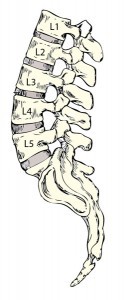Before discussing lumbar fusion, it will be useful to briefly review the anatomy of the lumbar spine.
The Lumbar Spine

Vertebrae are the 24 bones that appear to be chained together to make up the backbone or vertebral column. The lumbar spine, specifically, is made up of five lumbar vertebrae located between the thoracic spine and the sacrum.
This area is commonly referred to as the “low back”. The lumbar vertebrae are the largest of the vertebrae because of their weight-bearing function. The vertebrae provide protection and support for the spinal cord and nerves. These structures lie within a large hole called the spinal canal. The spinal canal is surrounded by a large protective ring of bone that is formed by each vertebra.
Spinal nerves exit at each level between the vertebrae. Between each vertebrae is a disk (intervertebral disk) that acts as a shock absorber. There are numerous ligaments that support and strengthen the spine. Additionally, there are a large number of muscles that support and move the spine.
A spinal segment is made up of two vertebrae, the intervertebral disk between them, and the two spinal nerves that exit from each side of the spinal cord.
Refer to the following link for more information about the: Anatomy, Structure and Function of the Lower Back.
Lumbar Spinal Fusion
It is important to remember that in most cases, spinal fusion is an elective surgery that should only be considered after conservative treatments have been exhausted. Conservative treatments oftentimes include physical therapy, anti-inflammatory medications, osteopathic or chiropractic therapy, spinal injections, and acupuncture.
If conservative treatments fail to adequately resolve your leg and/or back pain, surgery may be an option for you. Additionally, there are certain situations where surgery may be recommended on a more urgent basis (e.g. loss of bowel and bladder control, progressive weakness, etc.) Typically, when surgery is recommended, X-rays, MRIs, and CT scans will have been ordered for surgical planning.
The purpose of spinal fusion is to relieve your pain by stopping the movement in the spinal segment that is causing your problem. Very commonly, at the time of surgery, a decompression will be performed as well to relieve any pinching of nerves that may be ongoing. There are numerous ways lumbar fusion can be performed. It can be performed through an incision in the back, in incision on your side, or an incision on your abdomen, or any combination of the above, depending on the cause of your problem.
With the number of different ways that surgery can be performed today, the surgical discussion can become quite confusing. It is just important to understand, that in many spinal conditions, there are usually several ways to address the same problem — all of which are acceptable and can result in great outcomes. Ultimately, you should go with the approach that your surgeon is most comfortable with i.e. has the most experience with. Perhaps most importantly, only proceed with surgery once you understand the risks associated with it and any alternatives that you may be able to consider trying before surgery. At the end of the day, whether surgery is right for you is only a question that you can answer.
Take a look at the links on this page. They were generated to answer many questions about your surgery. Read over all the information with your family and friends. It covers the entire surgical care episode including what happens before, during, and after your lumbar spinal fusion surgery. Remember, that your back is very unique, and that all back problems are very different. Any questions you may have after reading these articles should be directed at your treating surgeon.
Note that the information in this article is purely informative and should never be used in place of the advice of your treating physicians.
Lumbar Spinal Fusion
Table of Contents
Lumbar Spinal Fusion
Most Common Causes of Lumbar Back Pain
Your Visit With The Surgeon
Getting Yourself Ready For Surgery
Understanding Back Precautions
Making Arrangements For Surgery
Your Hospital Visit
Lumbar Spinal Fusion Surgery
Recovery At Home
When To Call Your Surgeon
Long Term Care For Your Back
